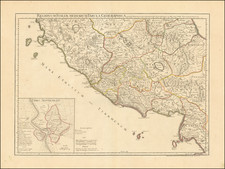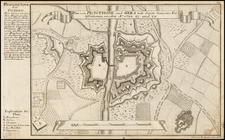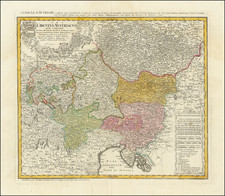Villa Farnese -- A Treasure Trove of Map Frescoes
Finely executed view of the famed Villa Farnese, in the town of Caprarola, a magnificent testament to the grandeur of Renaissance architecture and art, embodying the cultural and artistic achievements of 16th-century Italy.
Villa Farnese, is located in Caprarola, Italy. Designed initially by Antonio da Sangallo the Younger and later completed by Vignola in the mid-16th century, the Villa is a pentagonal fortress-palace. Its robust, fortress-like exterior, with its massive stone walls and defensive ramparts, contrasts with the interior's opulence. The building reflects the Renaissance ideals of symmetry, proportion, and geometric harmony, with a central circular courtyard that serves as the architectural focal point, linking various parts of the villa.
The interior of Villa Farnese is a veritable treasure trove of Renaissance art, with frescoes and decorations that speak to the Farnese family's wealth and cultural aspirations. Among its most striking features are the map paintings, located in the Sala del Mappamondo (Map Room) and the Sala dei Fasti Farnesiani. These frescoes, completed in the late 16th century, represent a unique confluence of art and cartography, reflecting the era's fascination with exploration and the expanding knowledge of the world.
The map paintings in the Sala del Mappmondo are particularly noteworthy. They depict various regions of the world as known at the time, including detailed representations of continents, countries, and seas. The accuracy of these maps is a testament to the Renaissance's advancements in geographic knowledge, driven by explorations and discoveries. The maps are not only cartographically significant but also artistically remarkable, with ornate embellishments and vivid colors that bring the dry subject of geography to life. The map frescoes were primarily created by the brothers Giovanni Antonio and Cherubino Alberti, Italian painters and engravers of the late Renaissance. The Alberti brothers, known for their mastery in fresco techniques and their contribution to the late Mannerist style, were part of a family of prominent artists
The inclusion of these maps goes beyond mere decoration or scholarly interest. They symbolize the power and prestige of the Farnese family, reflecting their political ambitions and their role in the broader narrative of the Italian Renaissance. The maps served as a visual assertion of knowledge and control, a common theme in Renaissance art and architecture where possession of knowledge was equated with power.
The Farnese Family
The Farnese family, originating from the Parma region in Italy, rose to significant prominence in the Renaissance period, becoming one of the most influential dynasties of the time. Their ascent to power and prestige is marked by strategic marriages, ecclesiastical advancement, and patronage of the arts.
The Farnese lineage can be traced back to the 12th century, but their substantial rise began in the 15th century with their increasing involvement in the political and ecclesiastical affairs of Italy. The family's fortunes took a decisive turn with the election of Alessandro Farnese as Pope Paul III in 1534. His papacy marked the beginning of the Farnese family's prominence in Italian and European politics.
Alessandro Farnese, ascending to the papacy as Paul III, was a pivotal figure in the family's history. His tenure as pope from 1534 to 1549 was marked by significant political and religious events, including the Counter-Reformation and the convening of the Council of Trent. Paul III's papacy was also characterized by nepotism, a common practice at the time, where he appointed his relatives to influential positions. He ensured that his family gained immense wealth and territories, including the Duchy of Parma and Piacenza.
The Farnese family were notable patrons of the arts, significantly contributing to the Renaissance's cultural landscape. They commissioned works from prominent artists and architects like Michelangelo, Antonio da Sangallo the Younger, and later, Vignola, who completed the family's most famous architectural project, the Farnese Palace in Rome, and Villa at Caprarola. These structures are testaments to the family's taste, wealth, and influence.
The Farnese extended their influence through strategic marital alliances. Notable marriages include that of Pier Luigi Farnese, son of Pope Paul III, to Gerolama Orsini, a union that strengthened the family's connections with other powerful Roman dynasties. Later, in the late 16th century, the marriage of Alexander Farnese, Duke of Parma and Piacenza, to Infanta Maria of Portugal, brought the family into the broader European political arena. Members of the Farnese family also gained fame as military leaders and statesmen. Alexander Farnese, the Duke of Parma, for instance, was a celebrated general in the Spanish service and played a crucial role in the wars in the Low Countries.
Georg Braun (1541-1622) was born and died in Cologne. His primary vocation was as Catholic cleric; he spent thirty-seven years as canon and dean at the church St. Maria ad Gradus, in Cologne. Braun was the chief editor of the Civitates orbis terrarum, the greatest book of town views ever published. His job entailed hiring artists, acquiring source material for the maps and views, and writing the text. In this role, he was assisted by Abraham Ortelius. Braun lived into his 80s, and he was the only member of the original team to witness the publication of the sixth volume in 1617.
Frans Hogenberg (ca. 1540-ca. 1590) was a Flemish and German engraver and mapmaker who also painted. He was born in Mechelen, south of Antwerp, the son of wood engraver and etcher Nicolas Hogenberg. Together with his father, brother (Remigius), uncle, and cousins, Frans was one member of a prominent artistic family in the Netherlands.
During the 1550s, Frans worked in Antwerp with the famous mapmaker Abraham Ortelius. There, he engraved the maps for Ortelius’ groundbreaking first atlas, published in Antwerp in 1570, along with Johannes van Deotecum and Ambrosius and Ferdinand Arsenius. It is suspected he engraved the title page as well. Later, Ortelius supported Hogenberg with information for a different project, the Civitates orbis terrarium (edited by Georg Braun, engraved by Hogenberg, published in six volumes, Cologne, 1572-1617). Hogenberg engraved the majority of the work’s 546 prospects and views.
It is possible that Frans spent some time in England while fleeing from religious persecution, but he was living and working in Cologne by 1580. That is the city where he died around 1590. In addition to his maps, he is known for his historical allegories and portraits. His brother, Remigius, also went on to some fame as an engraver, and he died around the same time as his brother.









![[ Bologna, Italy ] Bononia [on verso:] Bisantium Folium LXII](https://storage.googleapis.com/raremaps/img/small/101465.jpg)



![(War of the Austrian Succession) [Manuscript Map of the Surroundings of Savona in Liguria]](https://storage.googleapis.com/raremaps/img/small/87693op.jpg)
